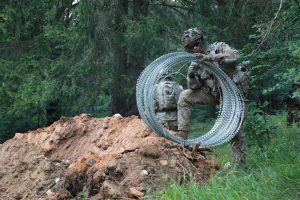500 Days and Counting – What Junior Officers can learn from the Ukraine-Russia Conflict

As of July 24th, the conflict in Ukraine has roiled without stopping. Important lessons that junior officers stand to gain insight from continue to emerge. Many of these lessons reinforce key doctrine and expectations of U.S. leadership. Dr. Jan Kallberg, a non-resident senior fellow with the Transatlantic Defense and Security Program at the Center for European Policy Analysis and Army Cyber Institute, recently wrote “Junior Officers on the Battlefields of Ukraine,” a piece important to the analysis in this article that showcases how Junior officers’ critical leadership characteristics (or lack thereof) impact battlefield effectiveness, team building, and capability.
This article calls to mind how Gen. Mark Milley, the Chairman of the Joint Chiefs of Staff, stated that Commanders need junior officers they can trust to act decisively, morally, and objectively in ambiguous situations. Combining this requirement with Mission Command (ADP 6-0) is the key to junior officer effectiveness and the cornerstone of the U.S. Army’s junior leadership strategy. As ADP 6-0 states, “Mission Command is the Army’s approach to command and control that empowers subordinate decision making and decentralized execution appropriate to the situation.”
Junior Officers on the Battlefields of Ukraine
The rapid and extensive losses of junior officers in Ukraine, the multi-functional nature of combat tasks, and shortened timeframe for fundamental combat skills training in active and reserve forces have created a leadership bottleneck that has drastically impacted mission success and consistency. Primary limiting factors in the War in Ukraine are no longer logistics related but a lack of trained and effective junior leadership. Leaders must be tactically competent and well-trained, but the human side of leadership cannot be understated at the junior officer level. Dr. Kallberg’s article highlights this, but we see successes and failures when trust, cohesion, and mission command are lacking in the junior officer ranks.
As the Soviet Union operated in a hierarchical and rigid top-down command structure, so has the Russian Army, limiting junior officers’ ability to make decisions reinforcing their competence, growing their character, and exemplifying care for their subordinates (Matthews and Lerner, 2018). Dr. Kallberg remarks that a rapid reassignment of Russian junior officers from non-combat branches, early graduation from military academies, and field promotions have occurred to combat losses. While none of these are easily or quickly implemented, the focus reinstates the importance of junior officers in leadership roles on the battlefield, regardless of previous or current experience or utilization. As such, Russia has taken a gamble that the quicker these roles are filled and maintained, the more combat experience will be gained. This “on-the-job training” approach has many limitations we see play out on the battlefield.
Similarly, the Ukrainian Army has rapidly expanded its military to a mass citizen army focused on combat forces who lack training but are offered significantly more freedom of maneuver to engage and destroy enemy forces. This rapidly moving, continuously assaulting force also theorizes that a large amount of battlefield learning and effectiveness will occur but comes at the expense of lessened cohesion, exhaustion, and constant risk analysis. However, despite less organic personnel, equipment, and munitions, the Ukrainian Army and its junior officers are effectively adapting to the battlespace by forming cohesive, functional units that can integrate technology and develop tactics, techniques, and procedures that reinforce what they are good at and effectively enhance outcomes.
We can gather many key takeaways from Dr. Kallberg’s article and what we have learned from the frontline. Below are a few areas Junior Officers could focus on:
Build Mutual Trust
The Junior Officer is the foundation of continuity of trust and cohesion at the company and platoon levels. Trust requires competence, character, and care – attributes regularly expected in leadership and example. By building credible psychological safety in extremis circumstances, a leader builds dependability and trust within their followers. Being clear about intentions and goals in line with your organizational structure will further team success and build trust at the lowest levels. In the Ukraine war, we have witnessed more adaptability and trust in junior officers after gaining experience. Rapid and successive combined arms operations, increased military innovation that implements technology, and strong leadership have resulted in successful counterattacks. This has built significant trust and enabled independent junior officer action. This trust supports a primary component of Dr. Kallberg’s thesis: maintaining momentum is essential to the Ukrainian Army’s success.
Focus on Cohesion
Without cohesion, individuals will not put themselves at risk. Tom Kolditz, a retired U.S. Army Brigadier General, studied in-extremis leadership thoroughly, from police SWAT team chiefs to military special operations soldiers. His analysis showed that followers are more likely to become cohesive with a leader and team with a learning orientation and shared risk. Mission command principles deal with and describe risk extensively. Two types of cohesion are visible on the contemporary Ukrainian battlefield: collective and task cohesion. Without collective cohesion or– many team members identifying with a team, organization, or shared purpose– we see a rapid degradation of trust in a higher authority. Examples such as PMC Wagner and Yevgeny Prigozhin’s assault on Rostov-on-Don and the subsequent march on Moscow in late June depict an apparent disengagement from senior military cohesion related to tasks and the collective nature and buy-in of the ongoing war in Ukraine.
Shared Understanding, Competence, and Disciplined Initiative
Planning and coordination are performed at the junior officer level by relying on NCOs and Soldiers to formulate and execute a plan, achieve tactical advantage, and continue movement to maintain momentum. This requires a junior officer to fully understand the battlespace and share that knowledge with others, not hoard it. While knowing your critical duties is essential, creating redundancy in training is vital. A key component of competence is repetition and drilling the fundamentals. An excellent junior officer drops ego at the door and plans training that teaches Soldiers what they know and the “why.” Lastly, a junior officer must understand second and third-order effects beyond the initial objective to provide exponential value to the broader organization. The disciplined initiative requires a junior officer to understand desired end states, and if the conditions exist to utilize momentum to achieve greater effects, a junior officer who can autonomously make those decisions while considering risk is of incredible utility.
By building mutual trust, focusing on cohesion, and developing shared understanding, competence, and disciplined initiative, junior officers can identify gaps in leadership and apply critical skills that develop a more effective fighting organization. Dr. Kallberg describes that Junior Officers on both sides of the Ukrainian war hold the lion’s share of responsibility for maintaining initiative and enabling increased operational freedom through decentralized command. While these are essential to Ukrainian success, the junior officer at home must think about how to train and make decisions that have built this trust before a conflict has started. As seen through Junior Officers on the battlefield in Ukraine, the earlier these characteristics are inculcated in a unit, the more effective it becomes.
Major Nick Rich is a Logistics Officer who has served in the 82nd Airborne Division and 10th Special Forces Group (Airborne). He is an Instructor at the United States Military Academy at West Point in the Behavioral Science and Leadership Department, teaching Sociology and Military Leadership.
Related Posts

Going Off Script, But Staying on Track: A Career Guide for Junior Leaders
Intro I walked into LTC Tomi King’s office as a new 2LT in his formation. We discussed all the normal talking points in that initial counseling – family, where I …

Fighting as an Enabler Leader
(U.S. Army Photo by Cpl. Tomarius Roberts, courtesy of DVIDS)Enablers provide capabilities to commanders that they either do not have on their own or do not have in sufficient quantity …

Defeating the Drone – From JMRC’s “Skynet Platoon”
If you can be seen, you can be killed—and a $7 drone might be all it takes. JMRC’s Skynet Platoon discuss their TTPs to defeat the drone.
